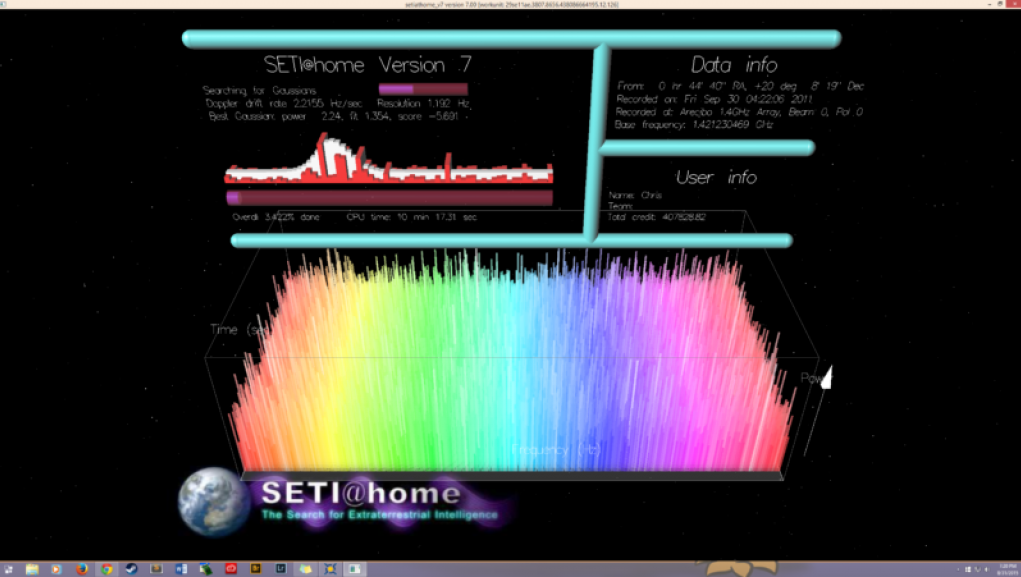Distributed computing burst onto the scene in 1999 with the release of SETI@home, an exciting program and screensaver that sifted through radio telescope signals for signs of alien life.
The concept of distributed computing is simple yet powerful: take a massive project, break it down into smaller pieces, and distribute those pieces to individual PCs for processing. There is no need for direct communication between the PCs; everything is coordinated through a central server. Each piece of the project is independent, meaning that one process doesn’t rely on the results of another. SETI@home was a perfect fit for distributed computing, as each work unit represented a unique moment in time and space observed by a radio telescope.
Fast forward twenty-one years, and SETI@home has shut down, having yielded no results. Countless PC cycles and electricity were expended with nothing to show for it. While we can only speculate on the reasons why people quit (feel free to share your thoughts in the comments section), the lack of tangible outcomes is a compelling explanation.
Rises and falls
SETI@home’s story mirrors the ebb and flow of the distributed computing world. Another significant effort came from IBM, whose Corporate Social Responsibility division played a role in creating the World Community Grid. This initiative focused on life science projects aimed at finding treatments for AIDS, cancer, and Alzheimer’s. IBM generously contributed its technology and talent to the project, which began in 2004. However, in 2021, IBM transferred the World Community Grid assets to the Krembil Research Institute, a part of the University Health Network (UHN) in Toronto. A UHN spokesperson declined to comment on this matter.
Advertisement
With the emergence of the COVID pandemic, a new star emerged in the distributed computing realm: Folding@home. This simulator aimed to understand how proteins adopt functional structures and had been simulating protein folding for over two decades to gain insights into disease formation. Folding@home had tangible results to showcase, with over 230 peer-reviewed papers published on its findings throughout the years. However, when it shifted its focus to studying proteins from SARS-CoV-2, Folding@home became the talk of the town. So many people joined the project that it surpassed the exaFLOP milestone before supercomputers did.
But as the pandemic subsided, interest in the project waned. Greg Bowman, the director of Folding@home and a professor of biochemistry at the University of Pennsylvania, noted that the project experienced a surge from 10,000 to 1 million active users but quickly dropped to around 45,000 active users. While this is still a significant increase compared to pre-pandemic numbers, Bowman believes there are multiple factors contributing to the decline. “The pandemic provided ample motivation and free time for new hobbies. Many organizations redirected their idle computers to Folding@home. For example, FIFA had no need to scan YouTube for pirated content since no games were taking place.” However, this surge was short-lived. “Inflation and energy prices skyrocketed,” Bowman explained.
Even DistributedComputing.info, an aggregator of distributed projects, experienced a hiatus before its January 2023 update. However, the site’s operator, Kirk Pearson, assures us that he hasn’t abandoned the project; he has simply been preoccupied with real-life matters.
In recent years, distributed computing has become increasingly important in the IT world as the focus shifts from centralized computing to distributed networks and architectures. But is it really dying or faded into the background?
Distributed computing, also known as grid computing or cloud computing, is a system in which multiple computers are networked together and linked to share resources and workloads, with a distributed application or service running across them. This type of computing eliminates the need for a centralized system or single point of failure, which improves reliability and scalability while making a system more efficient and secure.
The advantages of distributed computing cannot be denied. However, some argue that it is being overshadowed by more modern trends such as Machine Learning, Artificial Intelligence (AI), and other emerging technologies. Others believe that distributed computing is still in its infancy and is still a viable option for many businesses and organizations.
The truth is that distributed computing is not dying, but rather fading into the background. As more powerful technologies become available, distributed computing is being used less often in complex architectures. Instead, it is being used mainly for simpler tasks such as distributed databases, distributed analytics, and distributed web applications.
In addition, distributed computing technologies such as Hadoop and Apache Spark are still widely used, even if Machine Learning and AI have become more prominent in recent years. They have been essential in helping businesses handle large datasets and providing more reliable data processing and analytics.
Ultimately, distributed computing is still an important part of modern IT infrastructure. It is not dying or being left behind, but rather being integrated into other technologies to help create more powerful and efficient systems. As long as businesses continue to need distributed computing for specific tasks, it will remain a staple in the IT world.




















